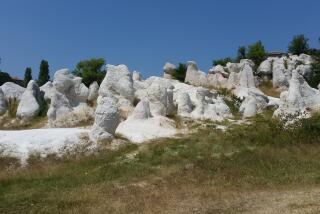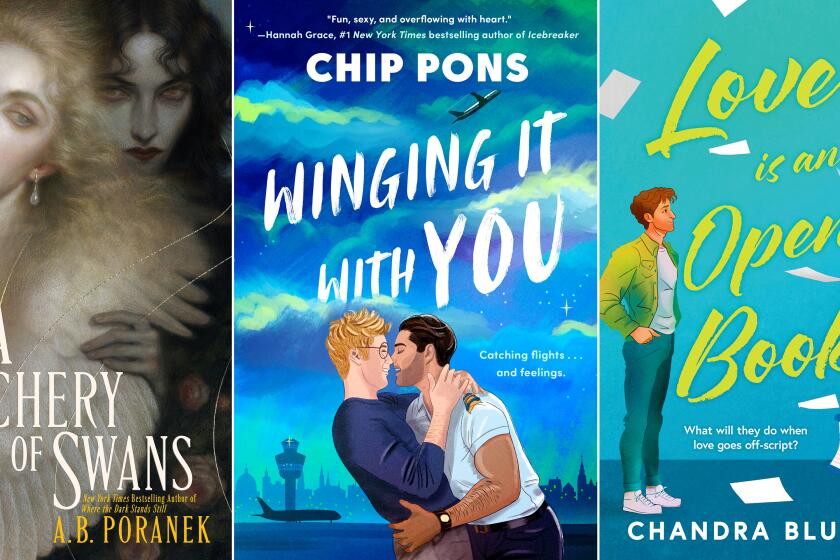Writer Explores Ghoulish Side of Dickens
- Share via
Charles Dickens used to visit the Paris morgue to stare at dead bodies. He fancied sketches of men gnawing human flesh.
“Do you think I’m making this up?” asked Harry Stone, moving his hands nervously.
Stone sits in a narrow office, surrounded by hundreds of books and drawings. The frail, white-haired man continually reaches for this or that volume, for some passage that will support his theory. Stone is convinced that Dickens was fascinated, perhaps obsessed, with cannibalism.
“He called it the ‘attraction of repulsion,’ ” Stone said. “He had nightmares about it. Hallucinations.”
For almost 30 years, Stone has taught English literature at California State University, Northridge. This is a man who read most of Dickens’ major works by age 12. He has made a career of studying Dickens and has published numerous highly regarded books on the 19th-Century author.
The book Stone is working on now, “The Night Side of Dickens: Cannibalism, Passion, Necessity,” may become his best-known, if only for its topic. It includes 300 pages of cannibalistic passages from Dickens’ novels, essays and articles.
On Wednesday--Ash Wednesday--the professor will discuss this research at a public meeting at the university.
“It’s academia par excellence, but it’s also sensational,” said Stone, 62. “If I were talking about Dickens’ view of Parliament, you’d be bored to death.
“There’s a little bit of the ghoul in all of us.”
This is an unusual way to approach Dickens’ work. But the author’s penchant for ghoulishness is not difficult to uncover. In a vivid scene from the first chapter of “Great Expectations,” the runaway convict Magwitch traps young Pip in a cemetery.
“You young dog,” said the man, licking his lips, “what fat cheeks you ha’ got. ... Darn me if I couldn’t eat ‘em. . . .
“You fail, or you go against my words in any partickler, no matter how small it is, and your heart and your liver shall be tore out, roasted and ate.”
Threatening Men a Symbol
Dickens often portrayed threatening men as ogres on the verge of chewing up young children, Stone found. The professor said these men symbolize how the adult world can terrify a child.
In “Bleak House,” cannibalism symbolizes the legal system devouring the accused. In “Tale of Two Cities”--where wine runs like blood in the streets and people are hacked limb-from-limb--cannibalism is used as a metaphor to describe how the French aristocracy consumed the commoners and how they, in turn, rose to consume the noblesse.
The French peasants daily execute enemies of the revolution. Dickens writes of their guillotine as a ravenous woman, “a sharp female newly born.”
“Lovely girls; bright women, brown-haired, black-haired, and gray; youths; stalwart men and old; gentle born and peasant born; all red wine for La Guillotine, all daily brought into light from the dark cellars of the loathsome prisons, and carried to her through the street to slake her devouring thirst.”
“It becomes a horrifying image for society,” Stone said. “Dog eat dog. Survival of the fittest.”
Childhood Tales
Dickens was still a child when first exposed to tales of man-eating men, the professor said. Dickens’ nursemaid told him such stories at bedtime. One story involved a man who marries a series of young women, then prepares them as meat pies. In another bedtime story, “Chips and the Devil,” young Chips sells his soul to the devil, who takes the form of a rat. The rat/devil eventually eats Chips.
“He used to hear this night after night,” Stone said. “He was terrified.”
These may seem perverse stories for a child, but accounts of cannibalism were a popular topic of news and discussion in the early 1800s, Stone said. At the time, English explorers were traveling to uncharted African regions and reported that cannibalism was practiced. One of the most talked about events of the era involved a British expedition that became stranded in the Arctic and ate their dead.
“If you think of fairy tales, this theme comes in often,” Stone said. “Think of ‘Little Red Riding Hood.’ In that story, the wolf eats the grandmother. Fairy tales don’t always end happily.”
Dickens later wrote numerous articles and essays about cannibalism. Another favorite topic was his series of visits to the Paris morgue. Unidentified corpses would be laid out for all to see in this squat, stone building built in the shadow of Notre Dame.
Stone discovered a tourist’s handbook from the mid-1800s that listed the morgue as an attraction of Paris.
“It became, after a little while, one of the sights to see in Paris, not only for visitors, but also for Parisians on a Sunday outing,” Stone said. “It was fascinating to see such a horrible thing.”
Stone offers a visitor several historic sketches of this morgue and people viewing bodies there. He has period cartoons and illustrations of people cooking in a stew and children eaten as soup. He has drawings of an insane asylum that Dickens toured once.
Rarely does academic research involve such gruesome fare, and Stone appreciates this. “The Night Side of Dickens” will also include a section on passion. That discussion, Stone said, can be left for another day.
“It’s not always this startling or sensational,” the professor said of his work. “It took a lot of detective work to track all this down. I found it fascinating to be doing this.”
More to Read
Sign up for our Book Club newsletter
Get the latest news, events and more from the Los Angeles Times Book Club, and help us get L.A. reading and talking.
You may occasionally receive promotional content from the Los Angeles Times.








